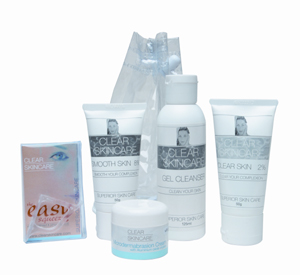Clearskincare

Why Clearskincare Works?
The goal of the Clearskincare programme is to restore the skin to its optimal condition and maintain it that way.The Clearskincare programme uses a combination of hydroquinone, Vitamin A either as tretinoin (Stieva A) or retinyl palmitate (New Skin) and the AHA, glycolic acid (Smooth Skin). This proven combination corrects skin conditions such as acne, hyperpigmentation and sun damage, and can be used on normal skin to keep it healthy and young.
With the Clearskincare programme, keratinocyte production is normalised, damaged DNA is repaired and new collagen and elastin are formed. These results produce smooth, clear, functioning skin that looks younger and brighter.
Clearskincare for Hyperpigmentation, Sun Spots and Freckles
Melanocytes (refer to diagram 1.) are melanin synthesising cells found scattered amongst the keratinocytes in the epidermis. Inside each melanocyte, tiny organelles known as melanosomes produce melanin pigment - the substance that determines skin colour. When the skin is exposed to UV radiation, the melanosomes are transferred to the surrounding keratinocytes where they protect the DNA in the nucleus of the keratinocyte from mutation. Without this protection, mutation can readily occur when the keratinocytes are exposed to the ultraviolet radiation. This skin protective mechanism is very easily overwhelmed if the amount of UV radiation the skin is exposed to exceeds the level the skin was genetically designed to protect against. That is why caucasian Australians have such a high incidence of skin cancer.When the skin protective mechanism is overwhelmed, a wide variety of hyperpigmentation conditions can result. UV light exposure, inflammation or hormonal changes can all overwhelm the melanocyte response. The Clearskincare programme helps regulate the pigmentary system and remove abnormal pigmentation.
Freckles
The first sign that the skin's melanin protection mechanism has been overwhelmed is the freckle. The problem is worse for fair skinned people living in tropical and temperate climates, climates where the indigenous skin colour is usually olive or black.Freckles are vertical clumps of melanin in the skin. With prolonged sun exposure, the skin will also develop horizontal clumping of melanin, which often appears in large patches on chronically sun exposed areas of the skin (the chest, neck and forearms are particularly vulnerable).
The Role of Hydroquinone (Clearskin 2% and 4%)
Used alone, hydroquinone decreases the formation and increases the degradation of melanosomes. It inhibits the activity of tyrosinase - the enzyme needed to make melanin. Hydroquinone is an effective bleaching agent used to correct pigmentation problems like melasma, freckles, or post inflammatory hyperpigmentation. Lightening of trouble spots may take up to two months, because the hydroquinone only prevents the production of new melanin. The bleaching effect is not permanent, since melanin can be stimulated by many factors.Used alone, hydroquinone will lighten hyperpigmented areas, but the results might not blend with the rest of the skin tone. When mixed with the rest of the Clearskincare creams the unique effect of blending occurs. This combination allows for a more even distribution of melanin to surrounding keratinocytes resulting in an even skin tone.
Clearskincare for Acne
Researchers in the past several decades have identified four components that contribute to the development of acne:Hormones
Androgens such as testosterone control the size and sebum output of the sebaceous glands. Some research indicates that it is not the amount of testosterone that matters as much as the normal conversion of testosterone into dihydrotestoterone or DHT. Some people have skin that is particularly sensitive to surface DHT levels.
Abnormal desquamation of sebaceous follicle cells
In acne prone skins, keratinocytes exfoliate at an abnormal rate. These cells fall into the hair follicles, become trapped along with excess sebum and cause clogged pores. This results in altered keratinization and the production of comedones.
Proliferation of P acnes bacterium
While propionibacterium acnes is found normally within a healthy skin environment, some researchers believe that acne-prone people generate an excess of the bacteria.
Excessive immune response
The body overreacts to what might ordinarily be a small, localised inflammation. The result is extreme inflammation and pus.
The single best topical treatment for acne is tretinoin (Retin A and Stieva A being the most common brands). A mainstay of acne therapy for nearly three decades tretinoin normalises the exfoliation of follicular cells, promotes drainage of existing comedones and inhibits formation of new comedones and inflammatory lesions.
In addition, tretinoin enhances the penetration of other topical agents - like antibacterial creams or alpha Hydroxy acids by causing the unplugged follicle to become more accessible. This inhibits the further growth of P. acnes bacterial and minimises the rupturing of comedones into surrounding tissue.
Tretinoin is used in conjunction with hydroquinone and glycolic acid in the treatment of acute acne. Each addresses the main pathology in acne and help stop the breakout cycle and return the skin to a healthy state.
The Role of Vitamin A (New Skin & Stieva A)
Topically applied Vitamin A, Tretinoin (Stieva A) was originally prescribed as a treatment for persistent acne. Patients and their doctors noticed that in addition to improving acne, Vitamin A / tretinoin had the unexpected side effect of producing smoother, less wrinkled skin.Many subsequent clinical trials have shown that Vitamin A is highly effective for treating sun damage, wrinkling, hyperpigmentation and facial roughness. Unlike the surface action of alpha hydroxy acids, Vitamin A directly affects a cell's nucleus where it binds the cell receptors. This binding allows it to regulate gene transcription that codes for the rate of cell division and turnover, cell differentiation and the production of new, healthy collagen and the repair of elastin. The result is firmer skin (from the collagen formation) as well as more flexible skin (from the repair of elastin).
Vitamin A also increases the formation of normal keratinocytes and fibroblasts, decreases melanocyte activity (which offers better resistance to the formation of hyperpigmentation as a result of external injury and inflammation), and in clinical studies it is shown to improve the formation of new blood vessels.
New Skin ( retinyl palmitate - 20,000 iu/g Vitamin A ) is an excellent but gentle carrier of Vitamin A. It provides significant skin rejuvenation, reducing fine lines and improvement in texture and colour without skin sensitivity or the risk or retinoid dermatitis. New Skin is suitable for most skins and can be used in place of a moisturiser or night cream.
Clearskincare for Sun Damage and Skin Ageing
As the skin ages, collagen breaks down and the skin loses its elasticity and even tone. New cells are slower to emerge, and the skin loses its ability to function properly. Skin health can be lost by a number of factors: chronological ageing and sun damage as well as conditions like hyperpigmentation, melasma, acne and acne scarring. There is no such thing as a healthy tan. The sun's ultraviolet rays are responsible for many skin problems including wrinkles, freckles, age spots and loss of elasticity. Exposure to the sun causes damage to melanocytes, destroys collagen, causes abnormally structured elastin and can trigger the production of cancerous skin cells.Normal ageing leads to the formation of some skin wrinkles. As the skin ages, the elastin fibres that keep the skin taut begin to loosen. This makes the skin sag. Other wrinkles may be caused by repeated facial expressions - like the vertical furrow lines that form between eyebrows.
How much sagging and how many wrinkles appear in middle age depends in part upon heredity. Most wrinkles, however, are caused by the cumulative effect of exposure to the ultraviolet rays of the sun. There are two types of ultraviolet rays: ultraviolet A (UVA) and ultraviolet B (UVB). UVA is associated with skin tanning, wrinkles and melanoma, a form of skin cancer. UVB is associated with sunburn and basal and squamous cell carcinoma, two types of skin cancer.
The Role of Vitamin C (Vitamin C Serum 10%)
Vitamin C is a powerful oxidant and in clinical tests has been shown to reduce the free radical damage caused in the skin by UV exposure and sunburn. Sun, smoking, stress, pollution and even normal eating and drinking can also produce free radicals that may damage the skin, by contributing to the breakdown of collagen. When collagen breaks down the skin sags and wrinkles.The problem with Vitamin C is that it is very unstable. For many years scientists worked on various ways to stabilise Vitamin C so that it could be used directly on the skin. For maximum effectiveness, Vitamin C should be used daily, as the body is unable to store it. As Vitamin C will oxidise when brought in contact with the air, Clearskincare recommends you replace your Vitamin C every three months.
Vitamin C is not a sunscreen and should always be used together with a 30+ SPF sunscreen.
The Role of Glycolic Acid (Smooth Skin 8%)
Glycolic acid is an alpha hydroxy acid. It is a very effective exfoliant, acting by dissolving the bonds between keratinocytes in the stratum corneum (refer to diagram 1.). In breakouts and open pores it is very helpful in reducing the numbers of keratinocytes and preventing the formation of the keratin plugs that commence the breakout cycle. It can be irritating to the skin in high concentrations, with no additional benefit for exfoliation. In sun damaged skins, it helps to soften the stratum corneum (refer to diagram 1.) through increased exfoliation.FREQUENTLY ASKED QUESTIONS
What is acne and how does it affect sufferers?Acne is one of the most common skin conditions affecting 20% of adults and up to 80% of teenagers. It is caused by over active sebaceous glands and excess keratin production leading to excessively oily skin that is prone to blackheads, white heads, pimples and cysts.
Acne is said to be one of the most socially debilitating health conditions, causing social withdrawal, poor body image, low self esteem and even depression.
Why is Clearskincare Different from other Acne Treatments?
The Clearskincare Acne Programme was developed from research into all the products that claimed to be successful for treating acne. Having identified the most effective ingredients, Dr. McCaffery formulated a range of products that could be used in conjunction with the prescription cream tretinoin, to treat and prevent all the aspects of active acne.
What makes Clearskincare unique is the effectiveness of the treatment, the affordability of the products and the low risk of adverse side effects. Other acne treatments involve the use of antibiotics or Roaccutane and these medications can have serious side effects. The Clearskincare programme is all topically applied, and the results can be seen after only a few weeks. Even with Roaccutane acne can come back after a period leaving the acne sufferer with no solution but to take the drug again. With Clearskincare the treatment is continual, and maintains acne free skin. Clearskincare also improves all aspects of the skin, helping improve scarring, skin texture, colour and appearance.
Another unique aspect of the Clearskincare is that the products and programme can be used by anyone, male or female of any age. Furthermore Clearskincare is extremely affordable, with products ranging from $10 - $55 making them accessible to all acne sufferers.
Can remote Australia access Clearskincare and the acne treatment programme?
Definitely. Acne is a problem for people all over Australia, with help and education for remote sufferers desperately needed. Dr. McCaffery has put together a document that can be sent out to acne patients, via email or mail. They can then take this to their local doctor who can prescribe the programme for them and monitor their treatment. Furthermore Clearskincare has a skin consultant at our clinic who is there to answer any questions and give advise to acne suffers over the phone or via email.
Where did it all begin?
Dr. McCaffery's research and the foundation of Clearskincare began when she bought a small beauty business 'The Caci Clinic' with the intention of turning it into a women's clinic. What she wasn't expecting was the unusual mix of patients, who had problems with excess hair and acne damaged skin. When researching different acne treatments she found they were either ineffective or extremely expensive, so she started reading textbooks and journals, anything she could get here hands on about treating acne.
In 2000, McCaffery decided to travel to California to train under one of America's top dermatologists. As a result she went on to formulate her own creams making them by hand, and over the next two years the demand grew so much it became apparent that she would have to find a manufacturer to meet the need. It was then that Clearskincare was born.
Visit www.clearskincare.com.au for more information!
MORE





